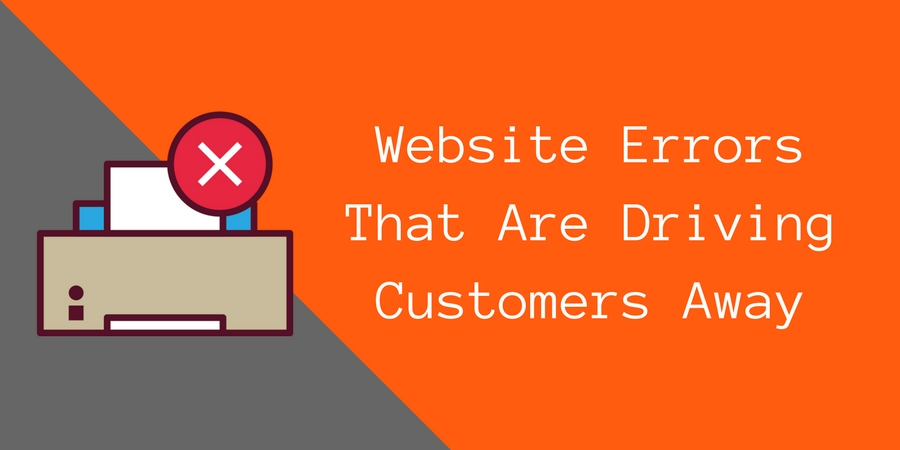Website Errors That Are Driving Customers Away: How to Find Them and Fix Them
As a business owner, you probably have a website. If you don’t, you likely want one. Websites assure that you reach customers, drive traffic to your business, and sell products directly to your clients.
This lowers your overhead and cuts out the expensive middleman. Yes indeed, a website can be a great asset to your business. However, you will only reap these rewards if you make a website that is both functional and pleasing to the consumer.
You might be thinking, “Isn’t a website just a website?” The short answer to that question is a definitive NO! There are a lot of mistakes out there that you as a business owner can make when building your site, and they can do lasting damage to your business growth. At best, they can damage any prospects you might have. At worse, you’ll lose customers forever.
In this article, we will discuss the website mistakes that can stunt your business’s growth, as well as how to fix each of them. By the end of the article, you’ll have the necessary information you’ll need to make your website a far more pleasing place for your clients.
Focus is Key
It may be tempting to create a website that packs all sorts of information into the homepage. However, this is a really bad idea. Your homepage should not feature every tidbit of information. Narrow the focus of this page down. Focus on what you do and the services you offer. That way, the person visiting your site for the first time will know exactly what they should expect from your business at a glance.
Also, when making your homepage, be sure to take the time to point users to other needed information. For example, your homepage should have links to your frequently asked questions, contact form and discussion forum if you have to, along with the standard links to your online store and other amenities.
Down With The Wall!
The last thing you want on your website is a wall of text. Sure, large blocks of text are fine in books. However, reading online is not the same as reading a book, and most readers won’t sit through a mountain of text.
If you have to use lots of text, that’s okay. Just remember to put in plenty of visual breaks. Bullets, headings, and numbers are all good options.
You should also add a few well-placed photos or graphics as they give your readers something appealing to look at. Do not forget to leave an appropriate amount of white space.
Make It Legible, and Accessible
Obviously, it is not a good idea to put a light font on a light background, or a dark font on a dark background. However, there are some legibility and accessibility issues that are far less noticeable if you’re not thinking about them.
First, your website needs to be readable by as many people as possible. There are several ways you can achieve that. Probably the simplest is to pick a font that is not too large or too small, something that most people can read.
A second solution, though a bit more difficult is to have website themes. Make the text colors, backgrounds and other page elements adjustable by your users. That way, if someone is reading who has a visual impairment, they can still access your website.
Speaking of vision impairments, it is important to make your site accessible to people who use screen readers as well. A screen reader is a program, installed on a computer, that reads text on the screen aloud to a blind person. While screen readers will support most fonts and text sizes, it is important to make sure your website will work with one. To do this, there are various plug-ins that when loaded in your browser will render your site as a screen reader would see it.
In the same vein, it’s necessary to alt-text your pictures and graphics. Not only can screen readers not describe pictures, but there are still people out there using dial-up Internet, or low bandwidth cell service. You want your users to be able to understand your graphics. The descriptive text you add to your pictures will allow all sorts of people to use your site and will increase traffic tremendously.
Cut the Clutter
Noise and clutter aren’t things you want on your site. Do not make your customers wade through long blocks of copy, promos, and animations. Though you might have been trying to make them feel at home and give them an idea of what your company does, you’ll wind up doing the exact opposite. Noise and clutter confuse your clients, making them more apt to leave your site and not recommend it to their friends, which is the last thing you want.
Be Subtle
The goal of every business owner is to move prospects along in the sales process. However, blatant advertising is not the way to go. It will intimidate your visitors, making them not want to bother with your site.
A better way to move prospects along the sales process is to use information, solutions, and value. That way, you’re not having to carry the site on the weight of your ads.
Note that though pop-up ads are acceptable, full-screen pop-ups that are difficult to close will just make people angry, leading to frustration and dissatisfaction.
Is Your Navigation Usable?
You would think that a usable, obvious navigation panel would be common practice, wouldn’t you? Sadly, that is not the case. When designing your website, it’s important to ask yourself some questions. How easy is it going to be for a newbie to navigate your site? Are important links clearly marked and arranged in a way that makes sense? Do all your links point to their proper pages?
All of these are important questions to answer if you want users to be able to find their way around. Refrain from marking your links with icons if possible. If you do feel the need to use icons on your website, make sure they’re universally understandable. For instance, the link that leads back to the homepage should be marked with an icon of a house, as opposed to being marked with a raptor.
Update Your Info
If you want to gain prospects, it’s necessary to have the most up-to-date information you can. Every time something with your business changes, you need to update the website. That goes double if it’s a big thing. If you change your phone number, update the contact page. If you offer new products, update the site.
Contact Confusion
Finally, speaking of contact pages, it’s important to include a phone number. Even if the site is online and you include an email, that doesn’t mean that the consumer will want to contact you that way. You need to include as many avenues for contact as possible. It will maximize the number of potential customers you will reach.
Summing up!
There are a lot of website mistakes people make when designing their business sites. However, now that you have the information in this article, you can avoid making some of them yourself. Prepare to grow your business and increase your traffic. If you use the ideas we have suggested in this article, your business will grow and you will reap all of the rewards that a well-designed site provides.
Author Bio: Kevin is the head of www.residualincomesecrets.com. He provides useful tips on how to start a residual income business online. He is expert at content marketing and SEO.

